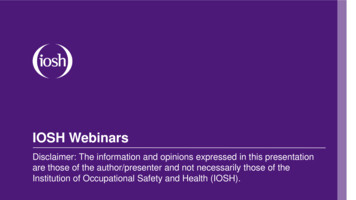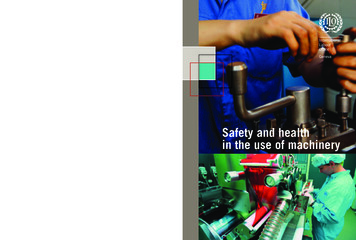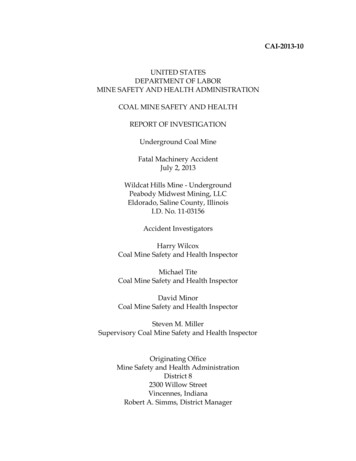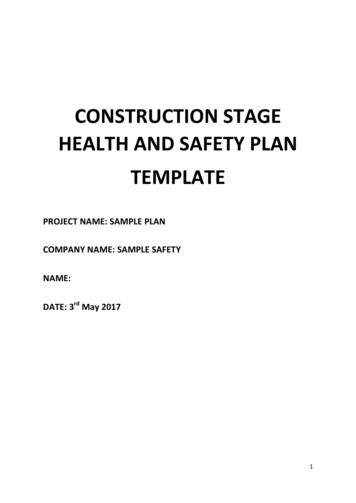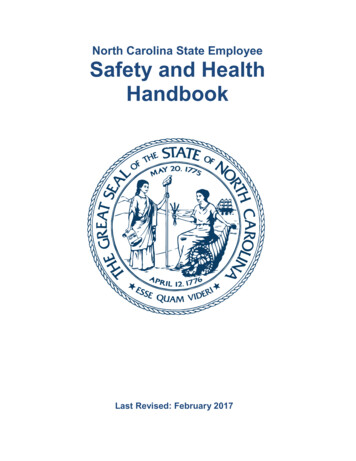
Transcription
North Carolina State EmployeeSafety and HealthHandbookLast Revised: February 2017
Table of ContentsPurpose . 2General Responsibilities . 3Employee Responsibilities . 3Supervisor/Management Responsibilities . 4Safety and Health Leader Responsibilities . 4Agency/University Responsibilities . 5Incident Investigation and Reporting . 6Complaint Procedure . 6First Aid . 6Hazard Recognition Program (Be a Hazard Hero) . 7Slips, Trips, and Falls Prevention . 8Back Injury Prevention Through Safe Lifting . 9Muscle Injury Prevention Through Ergonomic Interventions . 10Office Safety Injury Prevention . 12Medical Surveillance to Prevent Workplace Illness . 14Motor Vehicle Injury Prevention and Requirements . 14Fire Prevention . 15General Housekeeping/Sanitation/General Waste . 16Emergency Response Plan . 17Workplace Violence Prevention . 18Specific Safety and Health Programs . 19(The following sections are not required reading for all employees. Supervisors mustassign sections based on job duties, OSHA regulations, and exposure).Asbestos . 19Biological Hazards . 19Bloodborne Pathogens . 20Confined Spaces . 20Electrical Safety . 21Ground Fault Circuit Interrupters (GFCIs) . 21Hazard Communication Program . 22Chemical Inventory . 23Contractors . 23Lockout/Tagout – Control of Hazardous Energy. 23Machine Guarding . 24Noise . 25Personal Protective Equipment . 25Portable Ladders . 26Scaffolds . 27Powered Industrial Trucks/Material Handling Equipment . 28Tools – Hand and Power . 28Powder-Actuated Tools . 28Trenching and Excavations . 28Waste Disposal . 29
North CarolinaState Employee Safety & Health HandbookThe N. C. Industrial Commission Safety Department has accepted for filing the rules in thishandbook as the official safety and health rules under G.S. 97-12 N.C. Workers’ CompensationAct, for all state agencies and universities.Prepared by:State Safety and Health Steering CommitteePublished by:North Carolina Office of State Human ResourcesOriginally Published:Revised:1987July 1995February 2002February 2005October 2010April 2013September 2015June 2016February 20171
PurposeThis handbook is designed to give state employees a firm understanding of the state’s concernfor protecting its employees from job related injuries or illnesses. The handbook has beendeveloped to provide employees with answers to general questions regarding safety in theworkplace. This handbook affirms that most hazards are created by personnel and thuspersonnel are responsible for following procedures and being mindful of their surroundings toprevent hazards from developing.Each new employee should attend New Employee Orientation within 30 days of hire. During thisorientation you will be given facility-specific information regarding how to respond during variousemergencies. Your supervisor or Human Resources representative will also discuss site-specificsafety policies and programs for your work area. Your supervisor must inform you of safetyprocedures and required training you will need to do your job.Additionally, you should keep this handbook available for immediate access, as you would anyimportant job related personal property. If you are confronted with a situation not covered in thisdocument, consult your supervisor before making a decision.The following pages contain only some of the highlights of the Safety and Health Regulations forgeneral industry and construction under the North Carolina Occupational Safety and Health Act(NCOSHA) and other regulatory groups. It is not intended as a complete manual on safetyand health, but should be used as a guide to help prevent common hazards that mightdevelop in the workplace. For specific standards applicable to your agency or university,contact your safety and health leader or your supervisor.All employees are required to read and be familiar with the contents of this Safety and HealthHandbook.If you have questions about this handbook or any other safety-relatedissues. Contact your agency’s safety or human resources personnel.Safety Leader:Human Resources Representative:2
General ResponsibilitiesEmployee Responsibilities Employees have the right to report work-related injuries and illnesses. Employers areprohibited from discharging or in any manner discriminating against employees forreporting work-related injuries or illnesses. All injuries, including minor first aid treatment, occurring on the job and any illnessassociated with the job shall be reported promptly and in writing to your supervisor.Questions concerning medical treatment of these injuries/illnesses should also beaddressed to the supervisor and your Worker’s Compensation Administrator. The protection of employees and the public onstate property is a shared responsibility of everyemployee. Working while impaired by alcohol or drugs isstrictly forbidden. The use of prescription drugs,which may affect your alertness or workabilities, must be reported to your supervisor orHR Department prior to beginning work. Failure to comply with or enforce Safety andHealth Rules and Regulations may result indisciplinary action up to and including dismissal.Violation of work rules is a job performanceissue and shall be dealt with through the jobperformance disciplinary process. Part of each employee’s job is to makerecommendations to improve the safety andhealth in the workplace. Employees shall wear, clean, maintain, and useprescribed personal protective equipment (PPE)for work that requires such equipment.Hazard HintMake sure you immediatelyreport the following to yoursupervisor:InjuriesNear hitsHazardous conditionsBurning odorsFiresDamage to propertyState vehicle accidentsHazardous material spillsUnsafe behaviorsViolations of proceduresLet’s keep everyone safe! Employees should refrain from operating any equipment without proper instructions,training, and authorization. Employees should only use properly guarded equipment. They should not remove orattempt to defeat safety devices.3
Employees should not indulge in any form of “horseplay”, which is strictly prohibited.Supervisor/Manager ResponsibilitiesSupervisors and managers should: Recognize that the most valuable asset in state government is employees and protectingemployee safety and health is the greatest responsibility of state government. Remind employees to report all hazards, near hits, property damage, incidents, andinjuries to their supervisor immediately. Workplace hazards shall be reported by usingthe “Be a Hazard Hero” form or at hazards.nc.gov. Investigate near hits, property damage, incidents, and injuries as soon as possible, firstdetermining whether a hazard is still present that could injure others. Eliminating orguarding against the hazard is a first priority after providing medical attention to theemployee (if injured). Investigate reported hazards and document results through the Hazard Hero reportingsystem. Send the completed form to the safety and health leader for your agency. Follow all reporting and documentation requirements found in the Incident Investigationand Reporting Program. Identify corrective actions and interim controls put in place for hazardous workenvironments under their control. Know and understand safety procedures and ensure that employees receive propersafety and health training. Start each day/shift with a short safety and health debriefing to review hazardsassociated with daily assignments, discuss injuries, or general safety topics. Lead or participate in hazard assessments and implement required engineering controls,administrative controls, and provide required personal protective equipment toemployees. Ensure that notification to the agency’s designated person occurs when regulatory (i.e.,OSHA, EPA, DEQ) inspections occur at their agency sites.Safety and Health Leader Responsibilities The safety and health leader for each agency is responsible for ensuring that the StateEmployee Workplace Requirements Program for Safety, Health and Workers’4
Compensation and OSHA regulations are created and implemented, along withassociated training classes. The safety and health leader should develop a risk assessment-based methodology tobe used in correcting workplace hazards on a priority basis throughout the agency,development of an agency safety and health documentation system for review ofeffectiveness, and establishment of long-range safety and health performance goals. The safety and health leader should submit a report annually to the agency headindicating achievements, identifying major problem areas, annual goals and objectives,long-range plans, and funding needs.Agency/University Responsibilities The agency or university shall develop and maintain an effective occupational safety andhealth program, including life safety and property protection. No agency or university shall knowingly require an employee to work in conditions thatare hazardous without proper training and personal protective equipment (PPE). Frequent and regular inspections of the workplace, materials, and equipment shall bemade by trained persons designated by each agency or university. Unsafe tools, materials, or equipment shall be tagged, locked, or removed from theworkplace to prevent their use. The agency or university shall instruct each employee on how to recognize and avoidunsafe conditions, unsafe work practices, and the regulations and/or standardsapplicable to their work environment to control or eliminate any hazards. The agency or university shall provide medical services required for on-the-job injuries orillnesses. The agency or university is responsible for compensation to the employee forwages lost from work and/or any disability rating as a result of the on-the-jobinjury/illness. For more information, see the Worker’s Compensation website. All employees, escorted visitors, and contractors shall be informed of hazards beforeentering a designated hazardous, caution, or restricted area; shall use required PPE;and shall adhere to safety and health procedures immediately upon access to the area. The agency or university shall provide appropriate PPE, conduct a hazard assessment,develop engineering controls, and/or provide training in the use of PPE whenever thereis exposure to hazardous conditions.5
The agency or university will designate safety and health committees as required,assuring equal representation in the composition of the committees betweenmanagement and employees.Incident Investigationand ReportingIf you have an accident, near hit, or if you are injured onthe job, you must notify your supervisor. See theEmployee Responsibility section of this handbook.Employees and supervisors should work together tocomplete the Incident Reporting and Investigationforms found on the OSHR website.If your injury requires medical treatment, follow theagency or university procedures regarding medicaltreatment. With reference to occupational disease, anemployee must give notice to the employer when theemployee is first informed by a competent medicalauthority of the nature and work related causes of theillness.If you have questions about coverage or benefits underworkers’ compensation you should contact yourWorkers’ Compensation Administrator.Complaint ProcedureHazard HintTo improve workplace safetyand health, we must collectuseful, accessible, and specificinjury and illness information.Employees and supervisors arerequired to document anyincident using forms found onthe Office of State HumanResources website and worktogether to develop correctiveactions that will preventinjuries. With this informationwe can work together to beproactive in preventingworkplace hazards.The complaint procedure is established to ensure open communication between all levels ofemployment to foster a safe and healthful workplace. There will not be reprisals nor sanctionstaken against any employee for bringing management’s attention to a safety and healthproblem. If after registering a complaint or concern with your supervisor you feel the need toprocess the complaint further, contact your safety leader or human resources representative.First AidFirst aid is the immediate emergency treatment provided for injury or sudden illness beforeprofessional medical care is available. First aid kits are required in all workplaces. First aid kitsshould be available for treatment of minor cuts and scratches; however, they are not asubstitute for obtaining medical treatment. Routine administration of first aid for other than6
minor cuts and scratches must be performed by certified first aid personnel (i.e. American RedCross, National Safety Council, etc.) or licensed medical personnel.Every facility must have a Bloodborne Pathogen Exposure Control Plan that describes who isresponsible for cleaning up blood and body fluids and methods to do this safely. Normally, theFirst Aid Team for the building, the clinic in the building or housekeeping would be responsible.If an employee has the symptoms of a medical emergency (i.e. stroke, heart attack, etc.) theemployer has the obligation to call 911 immediately even when the employee does not want tobe transported. The employee will be evaluated by EMS and can decide the next step after theevaluation.It is recommended that an Automated ExternalDefibrillator (AED) be installed in each building, whenpossible. The OSHA First Aid standard (29 CFR1910.151) requires trained first-aid providers at allworkplaces of any size if there is no “infirmary, clinic, orhospital in near proximity to the workplace which isused for the treatment of all injured employees.” Avoluntary first aid team should be trained in First Aid,CPR, AED use, and Bloodborne Pathogens. Neverminimize the seriousness of an injury or illness. If indoubt, seek medical attention.In the event of an emergency, immediately call foremergency services, locate someone trained in first aid,obtain the AED, and send someone to the front door todirect EMS staff to the scene.Flag the Hazard ReportingProgramHazard HintOver 90 percent of all injuriesare caused from unsafe acts. Toprevent injuries:Check your surroundingsbefore entering.Look for hazards andunsafe conditions.Ask your supervisor ifyou don’t know how todo the job safely.To prevent injuries a hazard recognition program has been developed to train workers on howto identify, correct and report unsafe behaviors and unsafe conditions. Hazards can be reportedonline at hazards.nc.gov and copies of the form can be obtained from your Safety and HealthLeader or by printing directly from the website.Employees are empowered to correct the unsafe condition immediately, if it is under their spanof control. Supervisors will involve employees in identifying solutions to the unsafe act orcondition, therefore creating a culture of caring.7
Safety Committees will be involved in reviewing the Hazard Hero reports, ensuring that hazardsare communicated across the agency to prevent similar hazards and possible injuries fromoccurring in other locations.Notify your supervisor and safety committee representative of any known hazards immediatelyand complete the hazard report.Slips, Trips, and Falls PreventionSlips, trips, and falls in state government are the number one cause of injuries. Many of theseincidents can be prevented by following these procedures: Keep work spaces, floor surfaces, walkways, and similar locations free of hazards (i.e.carpeted areas secured to floor, free of worn or frayed seams, tiles lying flat on the floor)and don’t present a tripping hazard. Chairs must be in safe, operable condition and designed to support the weight of theindividual. Broken chairs should be tagged “Do Not Use” until repaired or discarded. Sit in the center of a chair and not on the edge.Watch out for chairs on casters which can beinadvertently pushed from under you when youattempt to sit down. Place your hand behind youto make sure your chair is in place before yousettle into it. Do not stand or climb on a desk, chair, stool, orother unstable surface to reach for an object;always use a ladder.Hazard HintMany slips, trips and falls arecaused by being distractedwhile walking, using a cellphone, or carrying belongingsthat block your view of thewalkway. Place wastebaskets, briefcases, umbrellastands, and similar objects where they will notpresent a tripping hazard. When walking, maintain an erect posture, andwatch where you are going. To prevent slips and falls, select shoes that are slip-resistant, comfortable, supportive,and compatible with your work environment. Wear shoes at all times. To prevent trips, do not wear pants that drag the ground. When stepping down from a height of more than eight inches, step down backwards, notforward.8
Always use handrails when using stairways. Proper attention should be given to the act of going up and down stairs. Falls on stairsoccur when people are distracted while ascending and descending. Use caution when walking on uneven surfaces or surfaces which contain ice, snow,rock, oil, water, or other adverse or unstable material. Immediately clean spills.Back Injury Prevention Through Safe LiftingSerious strains often result from improper lifting and handling of boxes, office supplies, andequipment. Such objects should be moved with a hand truck or unpacked and handled insmaller parcels. Bulky objects shall be carried in such a way as not to obstruct the view ahead orinterfere with the use of handrails on stairways. Avoid placing heavy objects on bottom shelves or the floor if they must be picked upagain later. Heavy items should be stored near waist height and lighter objects onbottom or upper shelves. Use a mechanical device for heavy items, if possible, and inspect the device before use.If the object is too heavy, large, or awkward, get help. Avoid lifting above your shoulder height. Use a ladder or step stool to move objects atthese heights. Push rather than pull an object. While pushing, maintain your lumbar curve and pushwith your legs. Check the path before moving the load to ensure the path is clear and well-lighted, anddetermine where to put the load. To lift safely, spread your feet apart to keep a wide base of support, bend at your kneesinstead of at your waist and maintain your lumbar curve at all times, hold the object youare lifting as close to your body as possible and lift slowly, smoothly without jerking. Avoid a long reach to pick up an object and unnecessary twisting. Turn your feet, notyour hips or shoulders. Leave enough room to shift your feet so as not to have to twist.9
Take your time and use the same techniqueswhen setting down the object.Muscle Injury Prevention throughErgonomic InterventionsErgonomics is the science of fitting the job to theworker. Where feasible, the workplace should beevaluated to reduce the following risk factors: Repetition Inadequate work/rest scheduling Forceful exertions Awkward and extreme positions of the body Sustained or static positioning of the body.Hazard HintMuscle-related injuries are theNumber Two reported injury instate government. EmployeeErgonomic teams areencouraged in working groupsthat lift, push or pull frequently.Be sure to report to your supervisor any work-related discomforts. If you and your supervisor areunable to identify the source of the discomfort or find a solution, contact your Safety and HealthLeader for assistance. For workers who sit the majority of the day, it is a good idea to stand upevery hour and move around and stretch.As a state employee, you are in the best position toevaluate the tasks you do each day whether it is dataentry, microsurgery, or plumbing. The tips providedbelow are intended to provide you with the informationand basic tools necessary to assess and correct yourown job. If a repetitive job is awkward, try to find a betterway to accomplish it.Hazard HintMusculoskeletal disorders(MSDs) are a category ofinjuries that affect the body’smuscles, bones, ligaments,tendons, and nerves. Whenthere is a mismatch between thephysical requirements of the joband the physical capability ofthe worker, MSDs can result. When using vibrating tools, try to insulate thevibration from your hands with gloves, padding,etc. Keep your wrists in a neutral position as muchas possible, not bent or twisted. Use your whole hand to grasp objects, not justyour thumb and index finger. Alternate easy and hard tasks that require the use of your hands.10
Give your hand and wrist time to recover after forceful movements. Don’t carry heavy objects for long periods. Use jacks, carts, or dollies wheneverpossible. Increase the diameter of the handles of tools and equipment with tape, foam or othermaterials to help reduce the force of your grip and to spread the pressure more evenlyover the hand. Sit with your knees slightly higher than yourhips, with lower back against a firm backrest orpillow and feet flat on the floor or foot rest. Avoidleaning forward and try to allow your hips tosupport your torso. When standing, stand straight and maintainlumbar curve. Avoid bending at the waist. Forprolonged standing, use a low footstool foralternate resting of your legs and altering yourstance.Computer WorkstationsHere are some suggestions for setting up yourcomputer workstation properly:Hazard HintTo avoid sprains and strains,exercise every day, warm upand stretch prior to physicalexertion. Eat a well-balanceddiet to keep muscles strong andmaintain a healthy weight. Adopt a neutral posture. Sit with your lower back against the chair, your upper legsparallel to the floor and your feet flat on the floor or on a footrest. Adjust your desk height or keyboard tray so that your elbows are bent at right angles andyour forearms are approximately parallel to thefloor. Keep your wrists neutral (straight) by using awrist rest that is the same height as thekeyboard. Place your mouse (or other pointing device) ona surface close to and at the same height asyour keyboard.Hazard HintEmployees working at a deskshould get up every hour andmove and stretch to preventdiscomfort.11
Position your monitor directly in front of you,approximately an arm’s length away, with thetop of the screen at or slightly below eye level. Use a document holder to position work at eyelevel and close to the screen. Adjust your lighting and monitor to prevent glareor use an anti-glare filter.When performing tasks involving repetitivemotions or awkward positions, take periodicstretching breaks or alternate with other tasks.Hazard HintUse extra caution whenremoving staples from ajammed stapler or eye injuriesmay result.Office Safety Injury PreventionMany state employees work in office environments. Following safe work procedures in the officecan prevent many accidents. Do not attempt to carry stacks of materials which are high enough to obstruct yourvision. Close file drawers when not in use to avoid a trip hazard. Close cabinet doors to avoid head or leg injuries. Accidents can result when you stand in front of doors, so stand away from the path ofthe door swing. Use razor blades, knives, scissors, and other objects with sharp edges or points withcaution. Keep razor blades in protective containers. Never keep loose razor blades indesk drawers. Exercise care when loading or using staple machines to avoid eye injuries and puncturewounds. Use a proper staple remover for removing staples. Properly dispose of brokenstaple removers. Keep fingers away from the sharp edge of paper cutters. Never leave a cutting knife in araised position. All paper cutters should have proper finger protection. Do not store anything within 24 inches of the ceiling per fire code.12
Office Equipment Do not wear ties, loose fitting clothing, or longjewelry when using paper shredders to avoidaccidentally being fed into the paper entry port. Do not place computers or other officeequipment too close to the edge of a desk orother surface.Hazard HintUse only surge protectors orpower strips that have aninternal circuit breaker. Theseunits will trip the breaker if thepower strip is overloaded orshorted to prevent overheatingand fire and are listed by anational testing laboratory suchas Underwriter Laboratories(UL). The UL label must neverbe removed from the unit. Onthe underside of the casing,there should be themanufacturer's name and thename of the testing lab wherethe unit was tested. Outlet or light switch covers must be presentand free from cracks. Office equipment should be properly groundedor double insulated to safeguard againstelectrical shock. Do not use two-pronged extension cords oroutlet adapters in the workplace. Three prongedextension cords can ONLY be used as“temporary wiring” for up to 90 days and mustnot be plugged into another extension cord.Notify your supervisor if additional outlets arerequired. Extension cords should be protectedfrom accidental damage which may be causedby traffic, sharp corners, or pinching in doors orelsewhere.Surge protectors must be plugged directly into the wall and not into extension cords,another surge protector, or uninterruptible power supply (UPS). This practice is called"daisy chaining" or "piggy backing" and can lead to a short circuit or electrical fire. 13
Refrigerators, microwaves or equipment thatpulls high amperage must be plugged directlyinto a wall outlet. Do not place a surge protector or power strip inan area where the unit would be covered withcarpet, furniture, or any other item that will limitor prevent air circulation. Worn, frayed or damaged electric cords orconnectors should not be used and should betagged “Danger, Out of Service, Do Not Use”until replaced. If at any time the surge protector or power stripis hot to the touch, remove and replace the unit.Hazard HintNever use a cord or plug withevidence of burning, melting, orany other visible damage. If theinsulation is damaged ormissing, or the cord has comeloose from the plug, replace theunit. Never use a cord repairedwith electrical tape.Medical Surveillance to PreventWorkplace IllnessesWhen you work with certain toxic chemicals, infectiousdiseases, biological agents, excessive noise, or wearrespiratory protection, you are required to be medicallyevaluated. This evaluation may include periodicphysicals, blood or other biological testing, and othertests such as audiometric or pulmonary evaluations. Ifyou work with any of these, check with your supervisorand your safety and health leader for specificrequirements
First Aid . First aid is the immediate emergency treatment provided for injury or sudden illness before professional medical care is available. First aid kits are required in all workplaces. First aid kits should be available for treatment of minor cuts and scratches; however, t





